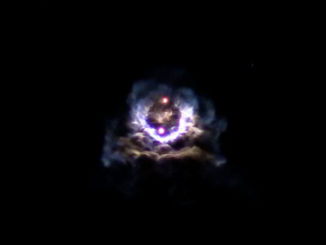
NASA announced Thursday that Orbital ATK has begun negotiations to lease a disused section of Kennedy Space Center’s iconic Vehicle Assembly Building and an Apollo-era launch platform for the company’s proposed next-generation rocket.
The space agency said it selected Orbital ATK to begin discussions to use High Bay 2 on the west side of the 525-foot-tall rocket assembly building and a mobile launch platform left over from the Apollo and space shuttle programs.
“Over the past few years, the people of Kennedy have worked diligently to transform the center. We are now a true multi-user spaceport supporting a variety of different partners successfully,” said Bob Cabana, Kennedy director. “We look forward to working with Orbital ATK in the future to help expand the capabilities of this unique, historic asset.”
NASA is outfitting High Bay 3 in the northeast quadrant of the VAB to stack the agency’s huge Space Launch System, which is set for its first test flight in late 2018. If NASA reaches a user agreement with Orbital ATK, the space agency would remain the VAB’s primary user and overall site operator.
The cavernous rocket integration hangar has four high bays, 325-ton cranes, huge doors, and a central transfer aisle to accommodate rockets up to 450 feet tall. NASA opened up High Bay 2 to potential commercial users in June 2015, and officials picked Orbital ATK as the top candidate to take over that portion of the VAB.
Orbital ATK’s new rocket would be powered by a large solid-fueled first stage and a liquid-fueled upper stage.
The Dulles, Virginia-based aerospace contractor is considering development of the new rocket to compete with United Launch Alliance and SpaceX for U.S. military launch contracts and other satellite launch opportunities.
ULA is retiring its medium-class Delta 4 rocket family in 2018 and the Atlas 5 rocket in the early 2020s, replacing them with the Vulcan launcher set to debut by the end of 2019.
SpaceX won permission from the Air Force last year to compete its Falcon 9 rocket for national security launch contracts, but that vehicle is not capable of lofting the military’s heavier payloads into orbit. Until SpaceX’s Falcon Heavy rocket begins launching and is certified by the Air Force — a milestone not expected until late 2017 — only ULA’s Delta 4-Heavy rocket covers all of the Pentagon’s launch requirements.
“Our objective is to develop a modular vehicle system capable of launching national security payloads and what is known as the EELV, or Evolved Expendable Launch Vehicle, (payloads), as well as scientific and commercial satellites, and to conduct initial launches using this new system by the end of the decade,” said David Thompson, president and CEO of Orbital ATK, in a Feb. 29 conference call with investors.
The company said in a statement Thursday that its potential use of assets at Kennedy Space Center is part of “preliminary planning” supporting the possible development of the EELV-class rocket.
Orbital ATK’s medium-lift Antares rocket tailored for cargo resupply missions to the International Space Station will remain based at the Mid-Atlantic Regional Spaceport at Wallops Island, Virginia, the company said.
“Orbital ATK has a long history of working with NASA’s Kennedy Space Center,” said Scott Lehr, president of Orbital ATK’s flight systems group. “We are excited about the possibility of utilizing KSC facilities for a future EELV-class launch system.”
Orbital ATK won a $47 million contract from the U.S. Air Force in January for early research and development work on the Common Booster Segment, a powerful solid-fueled rocket motor that would be the first stage of the company’s next-generation launch vehicle.
“The company and the U.S. Air Force are in the first phase of a potential four-year, jointly-funded development program aimed at creating a new all-domestic intermediate and large-class space launch vehicle family,” Thompson said.
The Air Force contract, which could be worth up to $180 million, also covers development of an extendable nozzle for the BE-3U upper stage engine, a hydrogen-fueled powerplant designed and manufactured by Blue Origin, Jeff Bezos’ space transportation company.
Orbital ATK officials said the company has three engine options for the new launcher’s upper stage, but officials consider the BE-3 engine the leading candidate.

Thompson said Orbital ATK will decide in early 2017 whether to proceed with full-scale development of the new rocket.
“Our investments in 2016, as well as those of the Air Force, will cover the initial phase of design and development work, with a decision in the first half of 2017 concerning the remaining activity to actually build and test this new launch vehicle family,” Thompson said Feb. 29.
According to Thompson, the next-generation rocket program is strengthened by the merger of Orbital Sciences and ATK to form Orbital ATK last year.
ATK built solid rocket boosters for the space shuttle and will produce more powerful rocket motors for the Space Launch System. ATK put forward the Liberty rocket concept, employing a U.S.-made solid-fueled first stage and a European upper stage based on the Ariane 5 rocket, to NASA’s commercial crew program in 2011, but the agency did not select the proposal for a contract.
The Liberty concept was based on ATK’s work on NASA’s canceled Ares 1 rocket designed to carry astronauts to space under the auspices of the Constellation moon program.
“There is certainly some important carryover from Ares 1 with regard to the solid rocket propulsion,” Thompson said. “It also benefits from, and in turn provides benefits to, NASA’s Space Launch System, which is, in a sense, a descendant of the Ares 1 project, and to some other NASA and defense programs as well. So there is a fair amount of carryover from prior work that ATK conducted back five years or (more) ago.”
Email the author.
Follow Stephen Clark on Twitter: @StephenClark1.



